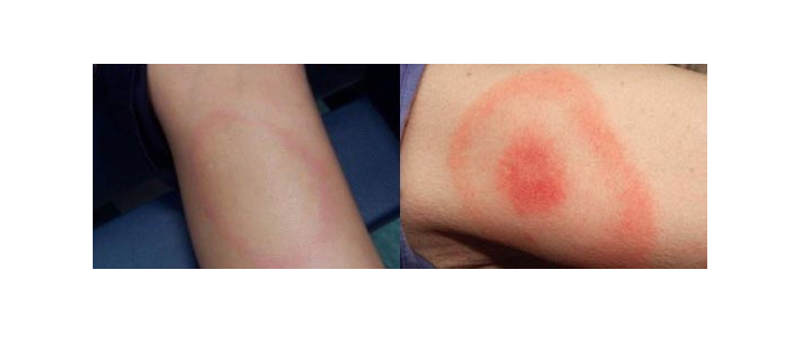Conditions, Signs and Symptoms caused by ticks
Conditions, Signs and Symptoms caused by ticks
This is probably the most commonly known disease to be passed on by ticks but not the only one. More information can be found on the Signs and symptoms of Lyme disease.
Rashes occurring within a few hours of a bite are not caused by Lyme disease and are likely to be simple allergic reactions or infections.
The most easily recognised symptom of Lyme disease is a bull’s eye / ‘Polo mint’ rash (as pictured). It may be very faint or vivid in colour. The colour can be shades of brown, red and pink. The rash gradually spreads from the bite site. It appears anything between a few days to several weeks after being bitten and is the only sure-fire symptom of Lyme disease. It is present in most but not all cases. It may disappear quickly so take a photograph so that the doctor has evidence of it and the site of the bite.
Other symptoms of Lyme disease can include:
- flu like symptoms
- fatigue
- muscle and joint pain
- partial paralysis of the face
- tingling or loss of sensation in the limbs.
TBE is a viral infection that can be spread to humans by the bite of tick. It is a rare infection that is only acquired abroad in some European and Asian countries. Scouting activities should factor this into their training and in their risk assessments.
Initial symptoms of TBE are similar to flu and can include:
• A high temperature (fever)
• A headache
• Tiredness
• Muscle pain
These symptoms usually last for up to eight days, after which point most people make a full recovery. However, some people go on to develop more serious symptoms caused by the virus spreading to the protective layer of tissue that covers the brain and spinal cord (meningitis) or the brain itself (encephalitis).
These 'second-stage' symptoms can include:
• Changes in mental state, such as confusion, drowsiness or disorientation
• Seizures (fits)
• Sensitivity to bright light (photophobia)
• Being unable to speak
• Paralysis (inability to move certain body parts)
These symptoms tend to get slowly better over a few weeks, but it may take several months or years to make a full recovery and there is a risk you could experience long-term complications.
If any of the above signs or symptoms appear, seek a doctor’s advice, immediately.
There are now confirmed cases of Britons who have suffered severe reactions as a result of suffering a tick bite and then later eating meat.
The allergy is caused when a tick bites deer, sheep, cattle, horses and pigs, and then bites a human. A substance in the tick's saliva triggers our immune system to overreact to meat, which contains the same substance.
Reported symptoms include:
• Itching
• Swelling of the mouth
• Wheezing
If any of the above signs or symptoms appear, seek a doctor’s advice, immediately.
There have been cases of Babesiosis in England. There have been 39 known cases on the European continent. Outside Europe, human babesiosis occurs mainly in the US.
Most people with babesiosis will have either no symptoms or mild symptoms of infection. However, people with weakened immune systems can become very ill, complaining of flu-like symptoms such as fever, chills, muscle ache, fatigue and jaundice.

Signs of Lyme disease
'Polo mint' rash. If any of the above signs or symptoms appear, seek a doctor’s advice, immediately. Lyme disease can be treated with a course of antibiotics.